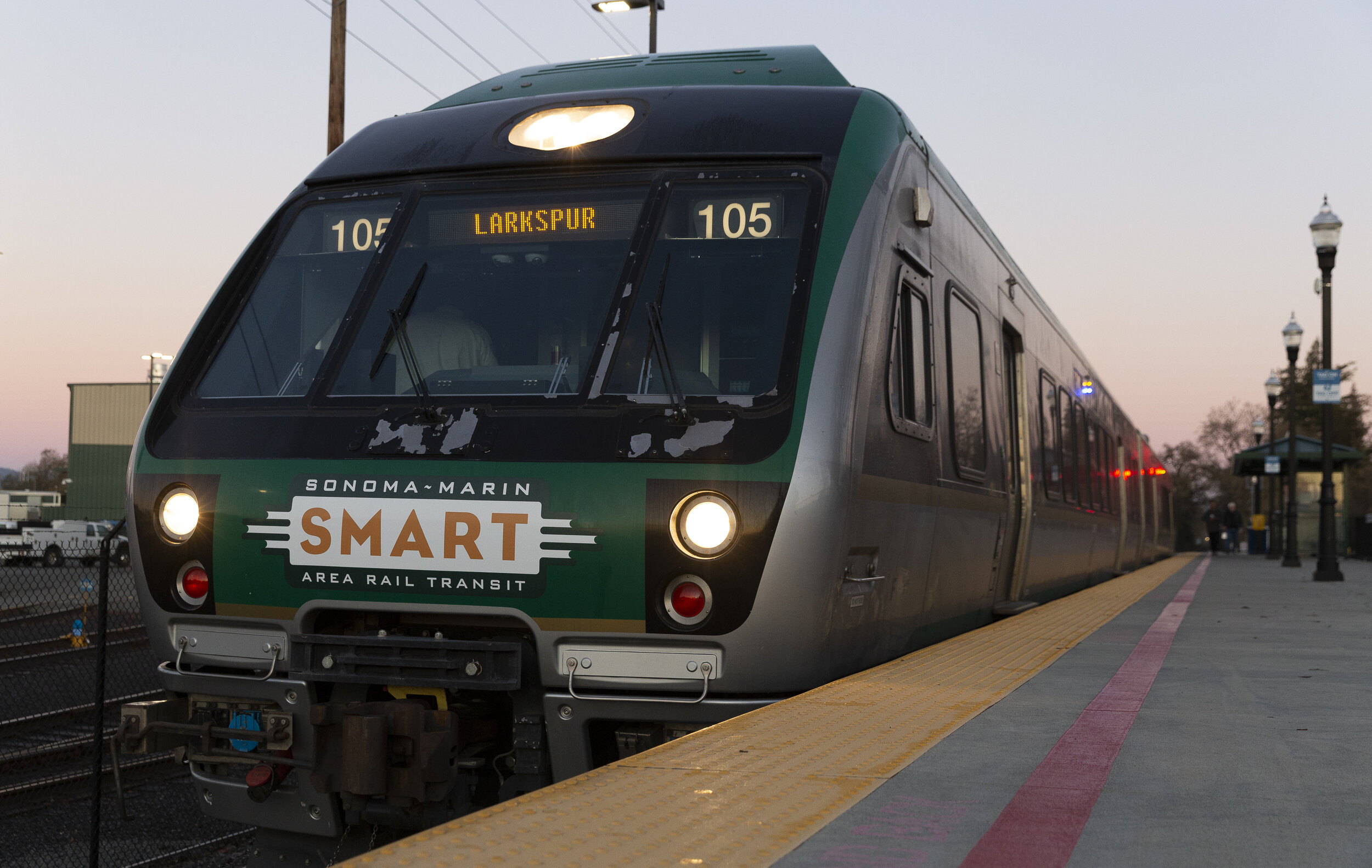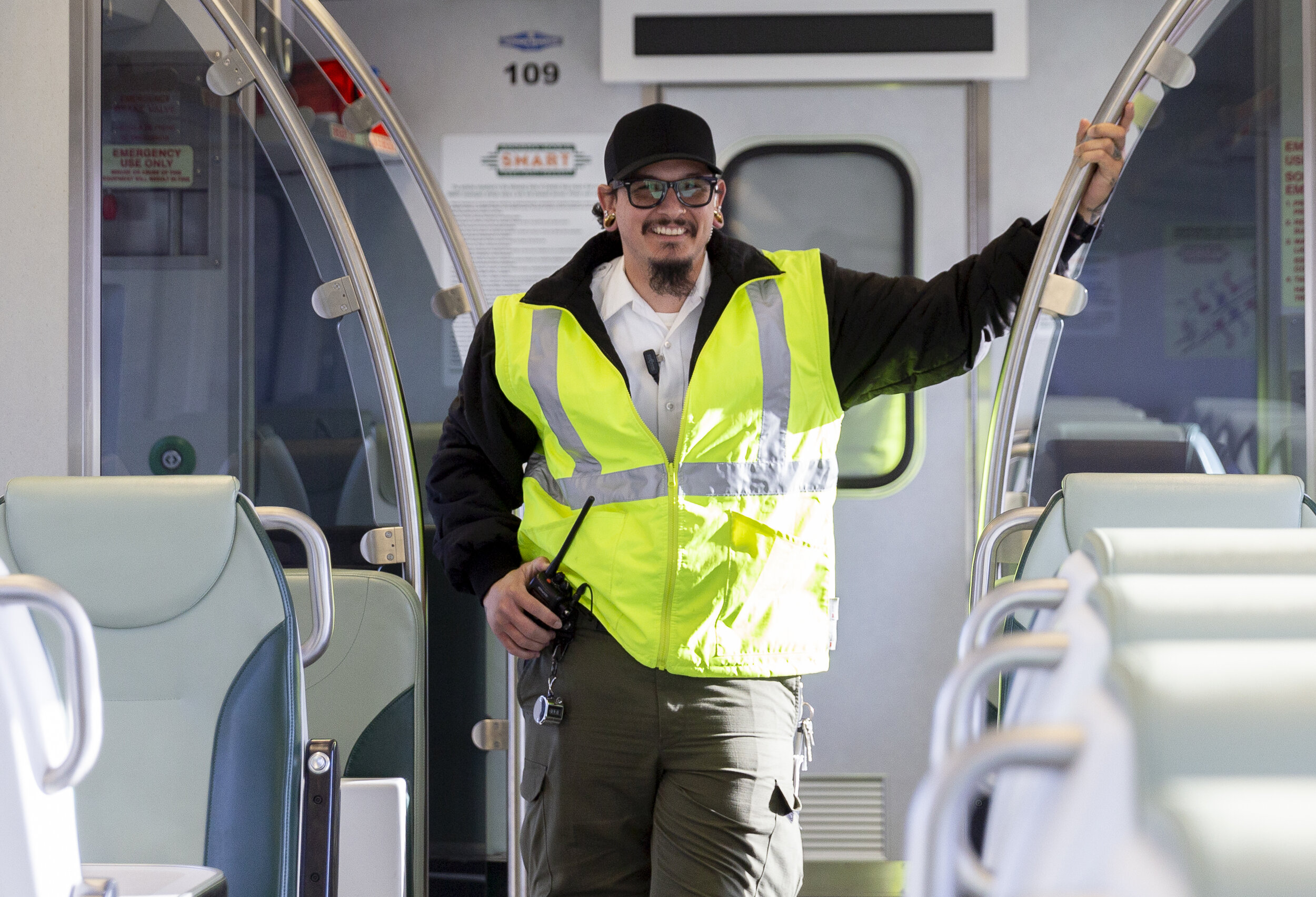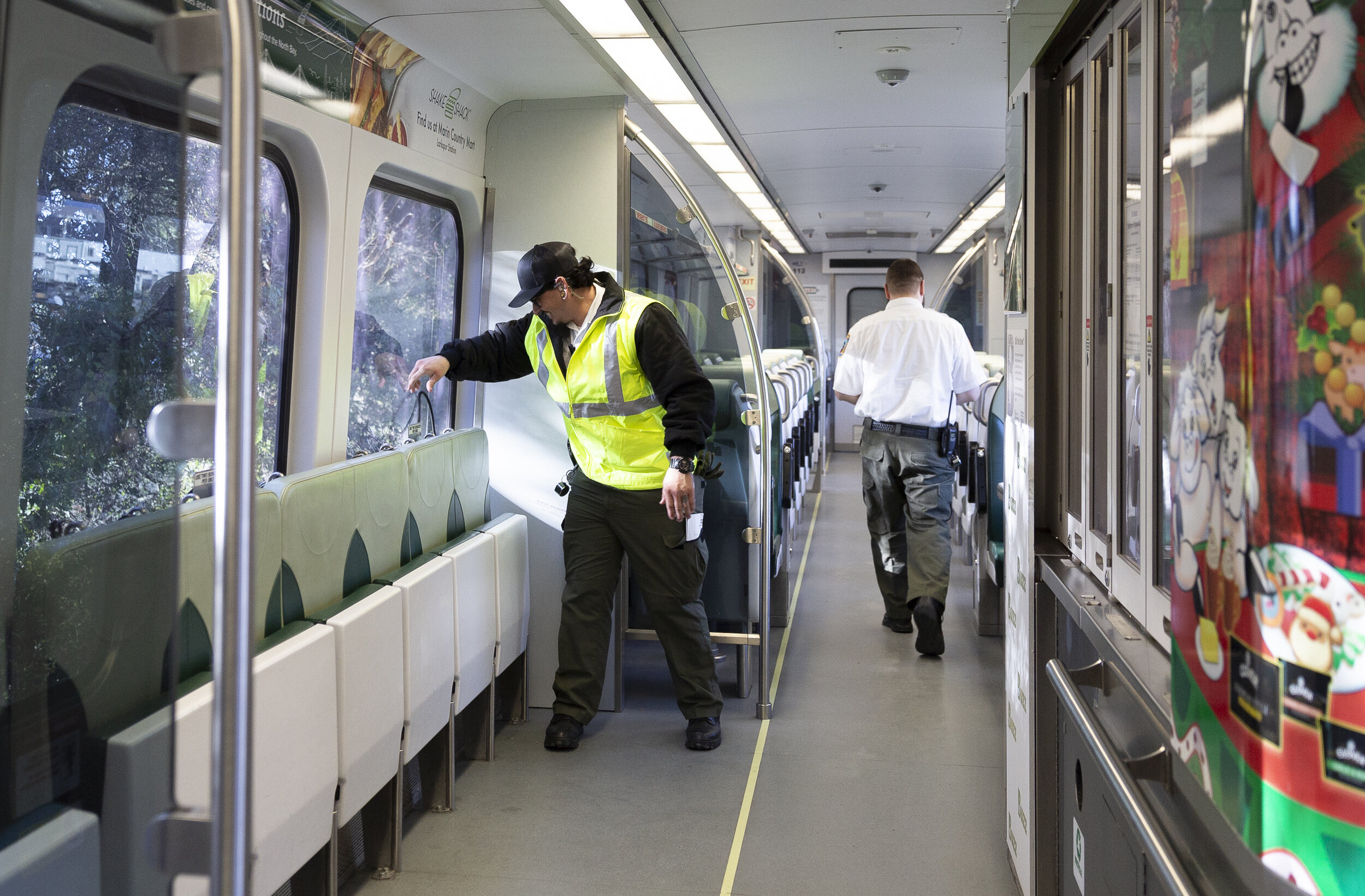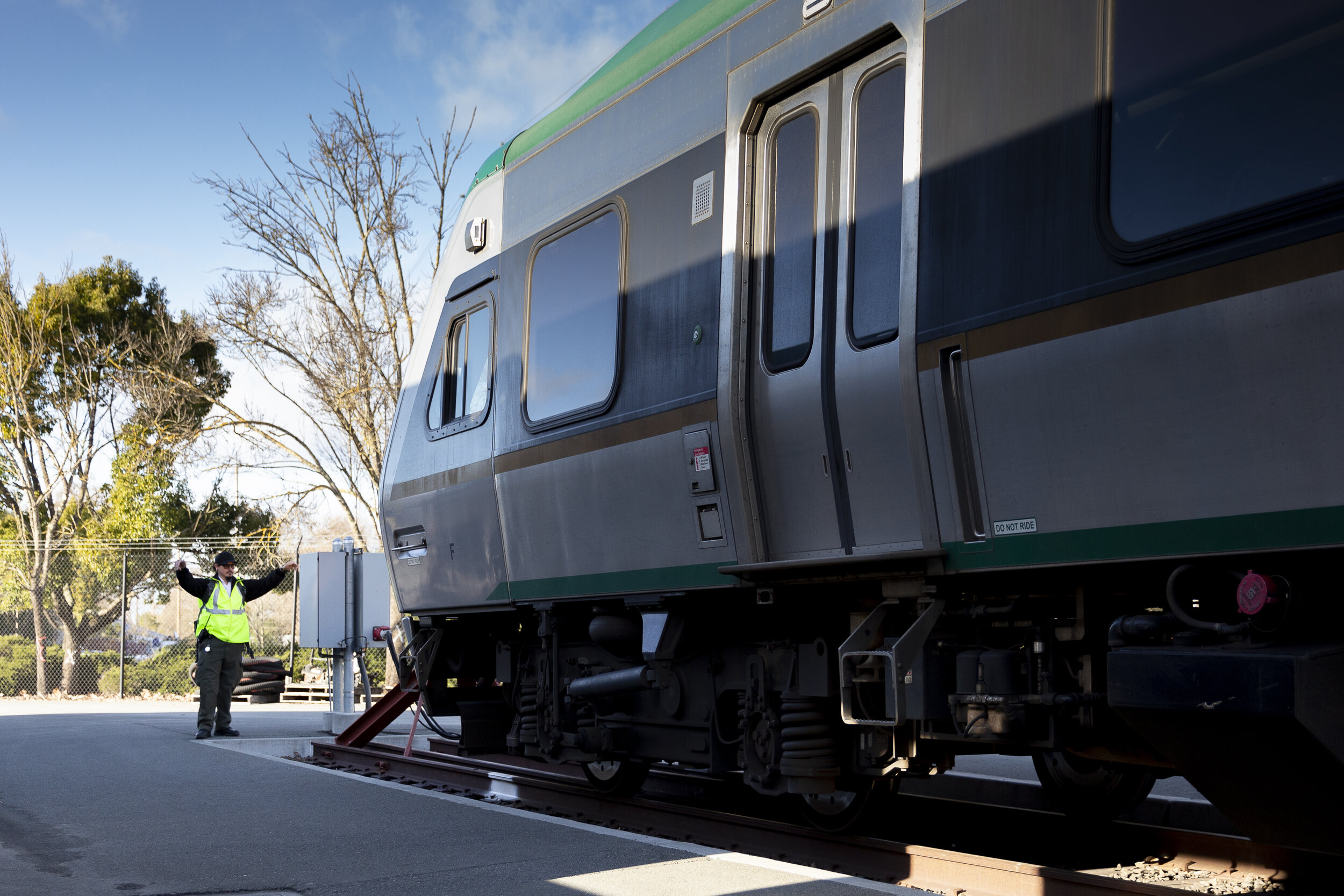Sonoma-Marin Area Rail Transit
SMART train stationed in the yard, prepared for departure on Sunday, Jan. 5, 2020, in Santa Rosa, CA. (Photo: Genesis Botello)
Featuring: Joseph Torrigino-Baca and Ryan Aranda.
Writer and Photographer: Genesis Botello
It's a chilly Sunday at 6:00 a.m. and the second day of the new train schedule. Engineer Ryan Aranda and Conductor Joseph Torrigino-Baca walk into work in their street clothes. It's a quiet start to the day as they make way to the locker room. Dry cleaned uniforms hung on a metal rack are ready for the crew. They put on the recognizable green pants and white button-up tops with a stitched badge on the left arm and a metal badge on the left side of the chest. They pin on their name badges and walk out towards a table with two laptops to clock in, fully prepared and ready to service the train for the day.
Joseph lists the equipment he needs,
"We have our radio, a clipper card reader to verify that they pay their fares. We also check the app on the passengers' phones, make sure they activate their tickets to get on the train. We also have a company-issued electronic device because we cannot have our cell phones on the train. We use it in case of emergencies or if our radio fails. Our paperwork, I carry the different schedules, make sure we have our safety glasses, high visibility vests, or jacket”
Joseph Torrigino-Baca (left) and Ryan Aranda (right) read through paperwork in preparation for the work day on Jan. 5, 2020, in Santa Rosa, CA. (Photo: Genesis Botello)
They leave the breakroom and meet with their supervisor on duty to receive paperwork and have a safety briefing. The paperwork informs the conductors of any restrictions, such as speed restrictions caused by workers doing maintenance near the tracks. Energized, Ryan and Joseph return to the breakroom and review the information with each other and discuss what will or can happen throughout the day.
Ryan mentions,
"Anything that will affect your movement and is safety-related, like speed restrictions or anything wrong with the alignment. Then we verify that information with each other and make sure we are on the same page before we go out to the train."
Joseph Torrigino-Baca walks in the train yard to board the train on Jan. 5, 2020, in Santa Rosa, CA. (Photo: Genesis Botello)
Trains lined up in rows prepared to run the weekend schedule on Jan. 5, 2020, in Santa Rosa, CA. (Photo: Genesis Botello)
At 6:15 a.m., Ryan and Joseph walk out to the trainyard. There are trains in rows on tracks that merge into one lane out to Santa Rosa Airport Station. Three trains are turned on and ready to leave the station. Ryan begins to walk around their assigned train and does a safety inspection. Joseph stays outside and removes the chocks that prevent the train from moving.
Ryan Aranda boarding the train on Jan. 5, 2020, in Santa Rosa, CA. (Photo: Genesis Botello)
Ryan then ascends the train and begins his safety check in the cab. He checks the lights, horns, bells, brakes, systems, and overall assures that everything is in good running condition. Joseph than comes on the train, and they begin to move out to the first station as Ryan honks the horn.
Daily log and equipment for the SMART train conductor-engineers. (Photo: Genesis Botello)
The conductor-engineer’s cab on Jan. 5, 2020. (Photo: Genesis Botello)
Joseph elaborates on safety,
"Everything is about safety. The railroad revolves around safety. Making sure that everything looks in place to safely move the train. Especially since we carry so many passengers every day."
Ryan Aranda (left) exiting the right cab and walking towards the left cab to move the train forward into Santa Rosa Airport station, Joseph Torrigino-Baca (right) training and observing Ryan on Jan. 5, 2020, in Santa Rosa, CA. (Photo: Genesis Botello)
The green-and-gray train pulls forward, then Ryan paces quickly to the opposing cab and reverses into the Santa Rosa Airport station. The train has two cabs on opposite sides, allowing it to move north or south. Ryan, an engineer, moves the train; Joseph is training to ‘mark-up’ to an engineer.
Ryan Aranda (left) in the cab changing switches, preparing to move the train forward, Joseph Torrigino-Baca (right) observes on Jan. 5, 2020, in Santa Rosa, CA. (Photo: Genesis Botello)
Joseph describes marking-up,
"I am now a 'mark-up' conductor, which means you will promote to a conductor. So when I came here I had experience, so the training is less than someone with no experience. There are many rules that you need to know and how to apply them in specific scenarios. It took me two weeks to 'mark-up,' and right now, I'm waiting for the engine service class so I can start training to be an engineer. It should be towards the end of this month. You need to have a minimum of 240 hours of what we call 'stick time,' which is running the train. A strenuous rules class that you need to go through for a couple weeks. Several tests you need to pass to become an engineer. So hopefully by July of this year, I will be running the train”
SMART train at the Santa Rosa Airport station on Sunday, Jan. 5, 2020, in Santa Rosa, CA. (Photo: Genesis Botello)
The train remains stationary as the morning sunlight turns cotton candy pink and blue. Passengers admire the train that was manufactured by Nippon Sharyo DMU. It’s powered with Cummins QSK19-R diesel engines that meet the EPA's rigid Tier 4 guidelines — allowing a smooth and fast ride that impresses new riders.
Conductor Joseph Torrigino-Baca, explains to passengers how to use the SMART app on their phone on Sunday, Jan. 5, 2020, in Santa Rosa, CA. (Photo: Genesis Botello)
The interior of the train is continuous with the green-and-grey design. Commodities on the train offer a restroom, areas to store bicycles, and the Buzz cafe by the non-profit organization, Becoming Independent, that serves snacks and beverages. There are options to sit at a table with four seats or a pair of reclinable chairs with tray tables.
Seats on the SMART train. Sunday, Jan. 5, 2020, in Santa Rosa, CA. (Photo: Genesis Botello)
Conductor, Joseph Torrigino-Baca, walks down the aisle verifying CLIPPER cards on the scanner on Sunday, Jan. 5, 2020. (Photo: Genesis Botello)
At 6:35 a.m., they begin their trip southbound. Joseph walks down the aisles while counting passengers on his clicker as the train glides on the concrete tracks.
On the way to the next station, Joseph shares his trajectory towards becoming a conductor on the SMART train.
Joseph Torrigino-Baca in a reflective yellow vest for high visibility when he walks in the train yard on Sunday, Jan. 5, 2020. (Photo: Genesis Botello)
"I worked in a fire department and after a couple years of trying to get a full-time job. I decided that I needed a good career. A couple of my friends mention that they worked for the railroad. So I applied for Union Pacific over in Roseville and Oakland and never heard anything back. I put it on hold on the back burner for a little bit."
The train approaches Santa Rosa downtown station, the same station built-in 1903 by the Northwestern Pacific Railroad. NWP preserved the right-of-way rail line after it closed in 1958. SMART train only changed the tracks and the railbed, as part of a rehabilitation project between downtown San Rafael to the Sonoma Airport estimated to be $428 million.
By August 25th, 2017, the first phase of the Sonoma-Marin Area Rail Transit opened. SMART began with a stock of seven two-car commuter trains. SMART traveled the identical route once taken by steam locomotives on a 43-mile segment between Santa Rosa Airport and downtown San Rafael. On December 14th, 2019, the rail line was extended to Larkspur, lengthening the section to 70-miles.
Joseph Torrigino-Baca talking into the earpiece radio on Sunday, Jan. 5, 2020. (Photo: Genesis Botello)
Joseph says "left side" into his earpiece. He is alerting Ryan to open the left doors for the passengers, avoiding the chance of opening the right doors that would not have a platform for passengers to walk on. As more passengers board the train, Joseph steps outside and reboard and says "high-ball" into the earpiece. And the warning beeping is accompanied by shutting doors, off the train goes to the next station.
Joseph continues his story,
"I applied for Burlington Northern Santa Fe in 2013, I got the job quickly, and I was there for six years and a month. Similar training as the Union Pacific. I went through 13 weeks of conductor training, it was part rules and on-the-job training. Then through an RCO program, a remote control operator, which is running a locomotive with no engineer. Then in July of last year I finally got the job here; pretty much how I got my start. I have been here for five months."
SMART train passengers enjoy the ride on Sunday, Jan. 5, 2020. (Photo: Genesis Botello)
At 8:12 a.m., they arrive at Petaluma Downtown, another historic station by NWP that opened in 1914. Joseph steps outside to make sure passengers are boarding and deboarding safely. Twenty new enthusiastic passengers board the train and rush to find the best seats on the train. Joseph comes back on the train, says "high-ball," and the train starts moving.
Outside the train are the green rolling hills of Sonoma County. They approach the Petaluma River, there a rolling lift bascule railroad bridge; named Haystack Landing Bridge. The train passes by the Petaluma wetlands, a couple looking out the window, trying to call the type of birds nesting in the area. They ask Joseph about the speed of the train. He responds,
"The fastest speed of the train is 79 mph. It will not let us go faster. There will be a penalty break that sounds like a buzzing".
At 8:27 a.m., the train arrives at downtown Novato, a historic station opened by NWP in 1879 and closed in 1958. It’s one of the two stations recently added by SMART, as of December 14th, 2019.
At 8:41 a.m., they arrive at Marin Civic Center station. Marin's significant era of rail was 1875-1930. In 1896, steam engines were pushing open-air cars. They filled with tourists from all over the world. By 1903, the rail lines became electrified - a pioneer innovation that helped develop Marin's cities and towns.
In 1869, Marin's first railway ran between Point San Quentin and San Rafael for three miles. By the mid-1880s, Tiburon and Sausalito were the port cities where ferries could then take freight and passengers on steam-powered trains on to San Francisco. From Cazadero in coastal Sonoma County or to Eureka, all rail lines followed the course of present-day Highway-101 that heading south to Marin.
The train continues to San Rafael station and the view from the windows turn dark as the train goes through the 1,320 feet long Puerto Suello Tunnel.
SMART train arrives at the Larkspur station on Sunday, Jan. 5, 2020, in Larkspur, CA. (Photo: Genesis Botello)
CLIPPER card scanner at the Larkspur station on Sunday, Jan. 5, 2020, Larkspur, CA. (Photo: Genesis Botello)
At 8:54, they arrive at the second newly-opened Larkspuk station. an exciting addition to commuters that travel from Sonoma County to San Francisco. SMART adjusted the weekend trips to be earlier to sync up with Golden Gate Ferry. Passengers deboard the train and make their way down to path towards the ferry.
Conductor-Engineer, Ryan Aranda, looking out towards the Santa Rosa Airport station on Jan. 5, 2020, in Santa Rosa, CA. (Photo: Genesis Botello)
During the 40 minute break at Larkspur station, Ryan comes out of the cabin. He is an engineer that has been working for SMART for two years since December. He shares his background as a conductor,
Joseph Torrigino-Baca (back) and Ryan Aranda (front) walking to the other side of the train on Sunday, Jan. 5, 2020. (Photo: Genesis Botello)
"I wanted a clear career path; I didn't know much about the railroad at all. I didn't know it was as common as it is. After being on deployment, I was deciding on what to do when I returned home. One of the lieutenants was a manager for the Union Pacific railroad and mentioned that they were hiring. He suggested that I give it a shot, many of us applied. Two months later, I was picked up, it was a six-month hiring process, and 10-12 months of training to become a conductor."
Joseph Torrigino-Baca (left) repositions bike bungies at the end of the day on Sunday, Jan. 5, 2020. (Photo: Genesis Botello)
Joseph sits near Ryan at one of the tables. They enjoy working together as they laugh at each other's jokes. I ask Joseph,
"What do you expect from your co-worker?"
Joseph Torrigino-Baca laughing at Ryan Aranda’s jokes on Sunday, Jan. 5, 2020. (Photo: Genesis Botello)
Joseph Torrigino-Baca (left) and Ryan Aranda (right) exchanging information on current events on Sunday, Jan. 5, 2020. (Photo: Genesis Botello)
Joseph responds,
"Communication is important between both conductors. Have a good attitude. When I arrived, I asked everyone I worked with, what do you expect from me, ask a conductor, what do you want me to do to help you out here?".
Ryan Aranda sharing a story with co-worker on Sunday, Jan. 5, 2020, in Larkspur, CA. (Photo: Genesis Botello)
Joseph demonstrates his devotion to being a collaborative and dynamic co-worker on the train.
Ryan smiles,
"Everyone is easy going here."
Joseph Torrigino-Baca checking his watch and schedule on Sunday, Jan. 5, 2020. (Photo: Genesis Botello)
As departure time approaches, Joseph looks at his watch.
"A watch that needs to be 100% accurate,” he says. “We need to leave at the exact time on the schedule. Don't be late, and don't be early- be on time."
Ryan Aranda running the train into the yard at the end of the day on Sunday, Jan. 5, 2020, in Santa Rosa, CA. (Photo: Genesis Botello)
Joseph Torrigino-Baca (left) and Ryan Aranda (right) running the train into the yard on Sunday, Jan. 5, 2020. (Photo: Genesis Botello)
Joseph Torrigino-Baca hand signals to aid in parking the train on Sunday, Jan. 5, 2020, in Santa Rosa, CA. (Photo: Genesis Botello)
By 2:51 p.m. on the fourth and last trip for train 1, they arrive at Santa Rosa Airport. Ryan runs the train back to the train yard. Joseph steps off the train to gestures with his arms to guide Ryan into the designated parking spot for the train.
Joseph Torrigino-Baca applies a chock on the train wheel on Sunday, Jan. 5, 2020, in Santa Rosa, CA. (Photo: Genesis Botello)
Parked, Joseph walks towards the end of the train and places a chock to keep the train in place.
Ryan and Joseph are two out of the 29 conductors working the SMART train. A day with the engineer conductors is usually entertaining. The level of dedication and professionalism is evident, as the passengers commute safely on the train every day. All thanks to the creation of the SMART train.
Author Jim Wood, from Marin Magazine, writes;
"It was sometime in the early 2000s," recalls Dietrich Stroeh, a Marin civic leader who's been active in community affairs since the 1960s. "I was on the board of the Golden Gate Bridge, Highway, and Transportation District, and we had this Northwestern Pacific Railroad right-of-way that was not being used." As Stroeh was talking with fellow board member and former mayor of San Rafael Al Boro, "suddenly I asked, 'Why not build a new railroad on it?'" With that, SMART, Sonoma-Marin Area Rail Transit, was born”




























